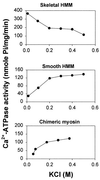The motor domain and the regulatory domain of myosin solely dictate enzymatic activity and phosphorylation-dependent regulation, respectively
- PMID: 8990166
- PMCID: PMC19241
- DOI: 10.1073/pnas.94.1.91
The motor domain and the regulatory domain of myosin solely dictate enzymatic activity and phosphorylation-dependent regulation, respectively
Abstract
While the structures of skeletal and smooth muscle myosins are homologous, they differ functionally from each other in several respects, i.e., motor activities and regulation. To investigate the molecular basis for these differences, we have produced a skeletal/smooth chimeric myosin molecule and analyzed the motor activities and regulation of this myosin. The produced chimeric myosin is composed of the globular motor domain of skeletal muscle myosin (Met1-Gly773) and the C-terminal long alpha-helix domain of myosin subfragment 1 as well as myosin subfragment 2 (Gly773-Ser1104) and light chains of smooth muscle myosin. Both the actin-activated ATPase activity and the actin-translocating activity of the chimeric myosin were completely regulated by light chain phosphorylation. On the other hand, the maximum actin-activated ATPase activity of the chimeric myosin was the same as skeletal myosin and thus much higher than smooth myosin. These results show that the C-terminal light chain-associated domain of myosin head solely confers regulation by light chain phosphorylation, whereas the motor domain determines the rate of ATP hydrolysis. This is the first report, to our knowledge, that directly determines the function of the two structurally separated domains in myosin head.
Figures





Similar articles
-
Mutagenesis of the phosphorylation site (serine 19) of smooth muscle myosin regulatory light chain and its effects on the properties of myosin.Biochemistry. 1994 Jan 25;33(3):840-7. doi: 10.1021/bi00169a027. Biochemistry. 1994. PMID: 8292613
-
Essential light chain modulates phosphorylation-dependent regulation of smooth muscle myosin.J Biochem. 2002 May;131(5):641-5. doi: 10.1093/oxfordjournals.jbchem.a003146. J Biochem. 2002. PMID: 11983069
-
The interaction between the regulatory light chain domains on two heads is critical for regulation of smooth muscle myosin.Biochemistry. 2000 Mar 7;39(9):2254-60. doi: 10.1021/bi9924617. Biochemistry. 2000. PMID: 10694391
-
Regulation and tuning of smooth muscle myosin.Am J Respir Crit Care Med. 1998 Nov;158(5 Pt 3):S95-9. doi: 10.1164/ajrccm.158.supplement_2.13tac400. Am J Respir Crit Care Med. 1998. PMID: 9817731 Review.
-
Regulation of the enzymatic and motor activities of myosin I.Biochim Biophys Acta. 2000 Mar 17;1496(1):23-35. doi: 10.1016/s0167-4889(00)00006-9. Biochim Biophys Acta. 2000. PMID: 10722874 Review.
Cited by
-
Preventative therapeutic approaches for hypertrophic cardiomyopathy.J Physiol. 2021 Jul;599(14):3495-3512. doi: 10.1113/JP279410. Epub 2020 Sep 7. J Physiol. 2021. PMID: 32822065 Free PMC article. Review.
-
The Role of the L-Type Ca2+ Channel in Altered Metabolic Activity in a Murine Model of Hypertrophic Cardiomyopathy.JACC Basic Transl Sci. 2016 Feb 13;1(1-2):61-72. doi: 10.1016/j.jacbts.2015.12.001. eCollection 2016 Jan-Feb. JACC Basic Transl Sci. 2016. PMID: 30167506 Free PMC article. Review.
-
The Central Role of the F-Actin Surface in Myosin Force Generation.Biology (Basel). 2021 Nov 23;10(12):1221. doi: 10.3390/biology10121221. Biology (Basel). 2021. PMID: 34943138 Free PMC article. Review.
-
Usher syndrome in Denmark: mutation spectrum and some clinical observations.Mol Genet Genomic Med. 2016 Jun 28;4(5):527-539. doi: 10.1002/mgg3.228. eCollection 2016 Sep. Mol Genet Genomic Med. 2016. PMID: 27957503 Free PMC article.
-
Exploring the therapeutic potential of the mitochondrial transfer-associated enzymatic machinery in brain degeneration.Front Physiol. 2023 Jul 28;14:1217815. doi: 10.3389/fphys.2023.1217815. eCollection 2023. Front Physiol. 2023. PMID: 37576343 Free PMC article. Review.
References
-
- Mooseker M S, Cheney R E. Annu Rev Cell Dev Biol. 1995;11:633–675. - PubMed
-
- Zot A S, Potter J D. Annu Rev Biophys Biophys Chem. 1987;16:535–559. - PubMed
-
- Hartshorne D J. In: Physiology of the Gastrointestinal Tract. 2nd Ed. Johnson L R, editor. Vol. 1. New York: Raven; 1987. pp. 423–482.
-
- Sellers J R, Adelstein R A. In: The Enzymes. Boyer P, Krebs E G, editors. Vol. 18. San Diego: Academic; 1987. pp. 381–418.
Publication types
MeSH terms
Substances
Grants and funding
LinkOut - more resources
Full Text Sources

